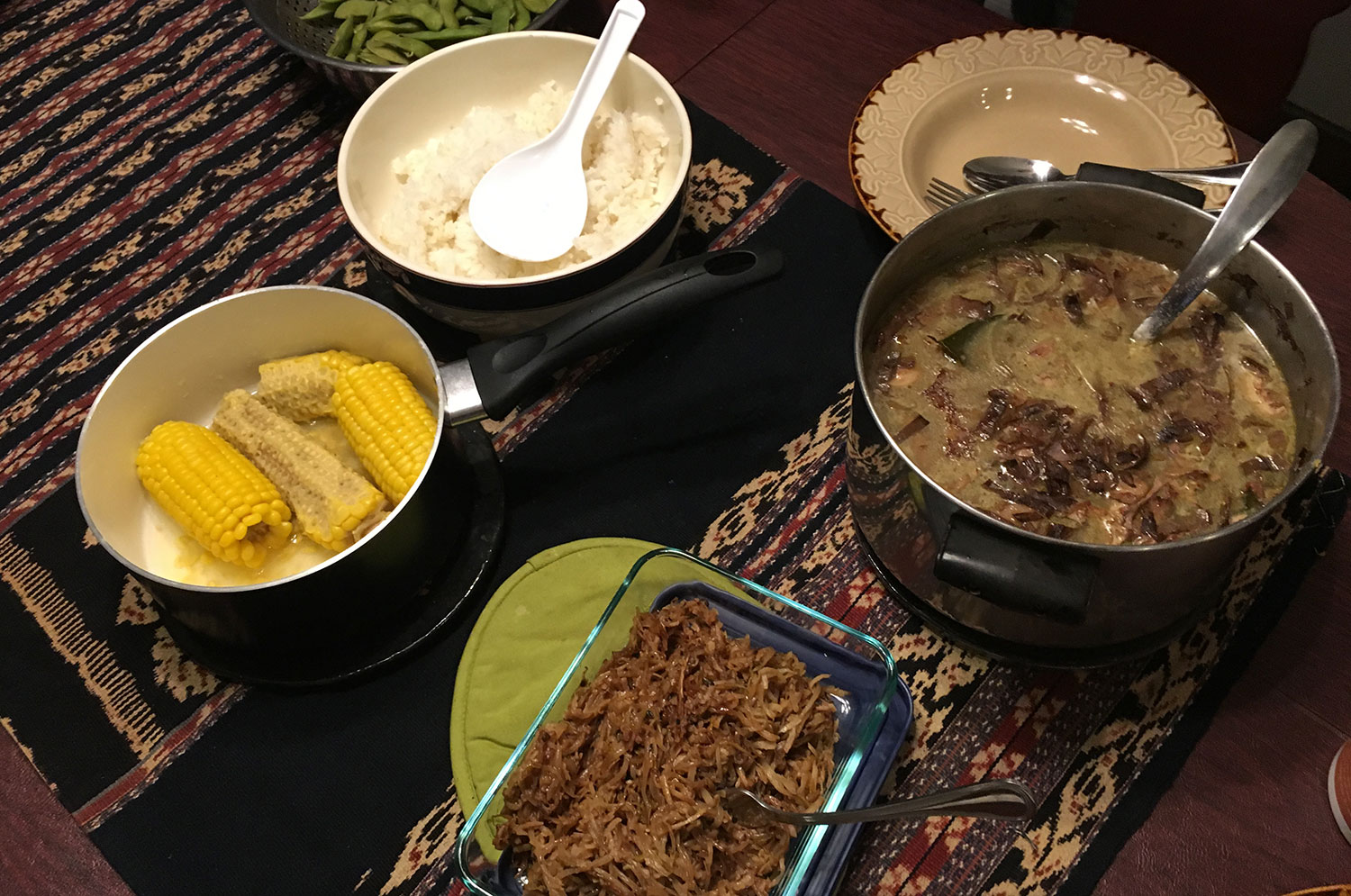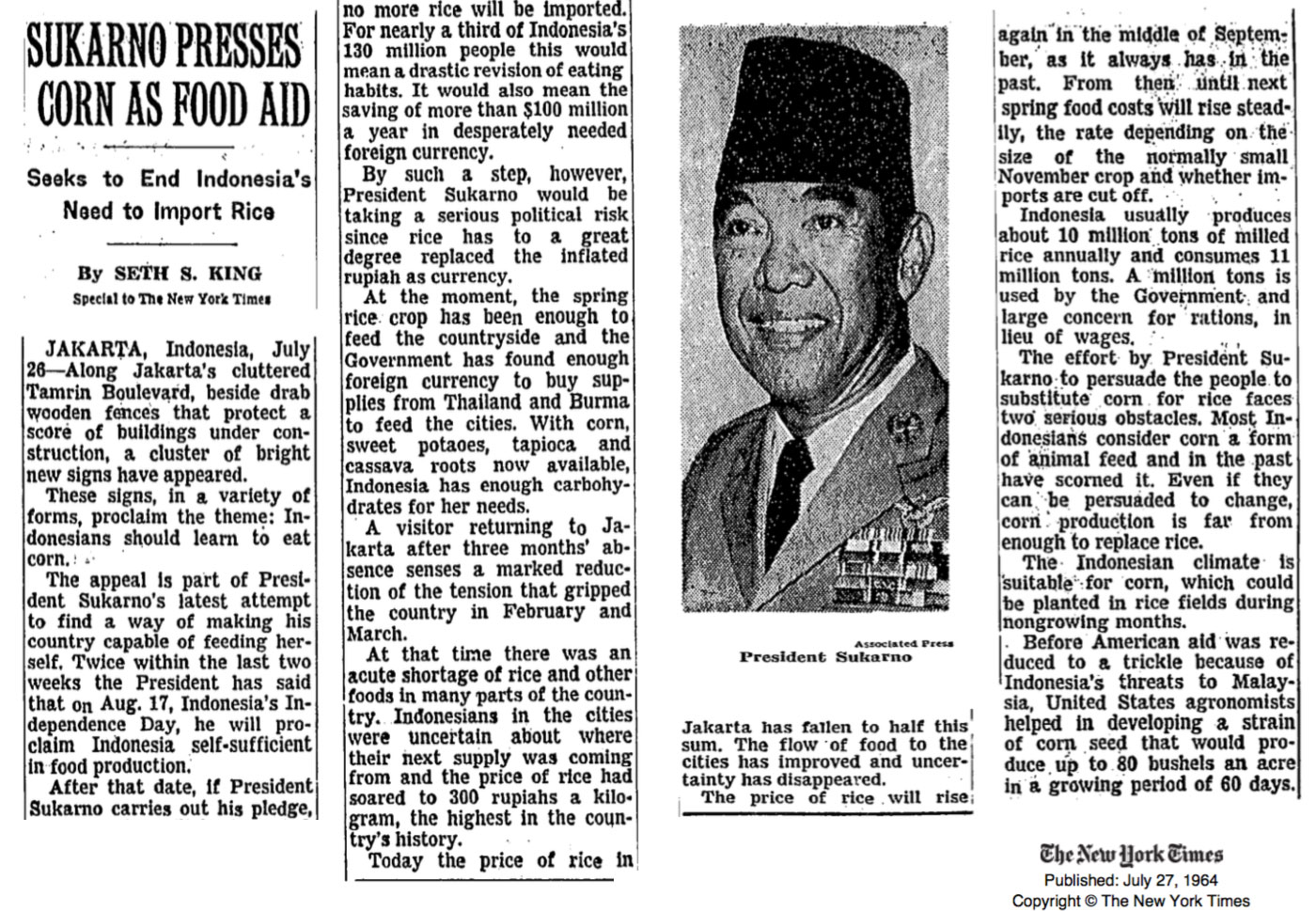Rice is stability.
17 October 2016 Told by Paula.

A typical meal during a visit to my parents in Florida.
Rice is stability. Food is survival.
When I went to visit my parents in Florida, I asked them about their memories of food throughout their lives, growing up in Indonesia and then immigrating to the West. Their stories of rice shortages spurred me to dig into the intersection of politics, economics, and food in Indonesia in the 1960s.
The rice shortage of 1964 was a harbinger of the greater chaos to come.
Throughout Sukarno’s presidency, rice shortages and price instability frequently occurred. Sukarno attempted to push for self-sufficient production of rice, but was unsuccessful1. My parents remember in particular the rice shortage in 1963/64, when Sukarno campaigned to substitute corn for rice.

Sukarno presses corn as food aid, NYTimes, 27 August 1964
These rice shortages were “part of the general economic malaise that contributed to the fall of Sukarno."2 When Sukarno’s Old Order fell and Suharto rose to power, an even greater push for self-sufficient production of rice emerged, and this time with aid from the West in the form of the Green Revolution.3 Eventually, Indonesia’s rice shortages would improve, but not without its downsides.
The Green Revolution brought an emphasis on monoculture, reducing biodiversity, around the same time the political environment ushered in a policy of anti-communist, nationalist assimilation.4, 5
The Green Revolution seemed largely a global economic effort, stabilizing the price of rice and fertilizer across developing countries. Within Indonesia and local economics, however, those with access to technology and landowning farmers benefitted more than the landless peasants, who fared as they had before the New Order.4
Alongside these new agricultural policies, Suharto’s New Order formed a committee in 1967 to address the ‘Chinese Problem’; ethnic Chinese in Indonesia had a reputation and were scapegoats much like Jews in Europe at the time. The solution was enforced assimilation, which banned Chinese festivals and encouraged ethnic Chinese to take on Indonesian names.5 This is why, for example, my family has had three different names in one generation (Chinese, Indonesian, and Americanized-Chinese).
The food my parents experienced was a merging of Indonesian, Dutch, and Chinese influences, representing not a confusion of identity but a reiteration of food as sustenance.
There was bubur congee, sop blanda, gudeg. Martabak, kueh lapis, kastengel, nian gao. There was always tofu and tempeh on the table. Nasi obviously.

A cookbook found in my parents' house: ethnic Chinese Cooking.
There are no special memories, flavors, or tastes my parents miss from their childhood in Indonesia.
It is simply the symbolism of food as survival that is relevant to my parents. Even when they moved abroad and food was no longer unstable, this frame of thought remained. Cook what is easy, they said. Make the same thing every day. Use powdered spices. Buy the cheaper one. This coincided well with the post-WWII industrial manufacture of food in America, in which cheap food was widely available in the form of processed, less nutritional shelf-stable goods.
At the same time, there are certain distinct cultural tendencies towards types of foods (bumbu, jangan, and kueh, for example).
Last April when I was in Florida, my parents had a bag of tortilla chips, and so we made salsa and guacamole as appetizers. The next day, my dad had mixed together the guac and the salsa, and had added sugar into it. “It tastes better this way,” he said.
The ketchup at KFC in Indonesia is sweeter than the ketchup in an American KFC. My dad prefers “wet” foods like soups and stews. Corn cannot be substituted for rice.
My parents do their own style of cooking, mixing frugality and tradition.
Mom doesn’t cook by any book. She says it doesn’t matter if you put the spices in right after the oil or at the end of the process. We didn’t have garlic and almost did without it until the last minute, when I jumped at the opportunity to buy a bulb of garlic with dad. This is the kind of cooking that made me not a very picky eater. There are interesting flavors to the food, but in a bland kind of way.
Today, my parents have found stability in new forms of food self-sufficiency.
Since my parents started their plant nursery as their primary business, they’ve slowly transitioned to eating the fruits and vegetables that grow on their land. Three bottles of powdered galangal spice remain unopened in the pantry, since they harvest the rhizome.

Washing vegetables from the garden.
Here’s an incomplete list the many foods they now harvest from their garden: lemongrass, pandan, ginger, turmeric, kefir limes, bay leaf, oregano, rosemary, parsley, tomatoes, loofa, bittermelon, papaya, beets, radish, cabbage, chard, collard greens, bok choy, surinam cherry, basil, okinawa spinach, peppers, string beans, peaches, tiny jackfruit, tamarind, starfruit, moringa, loquat, longan, starfruit, soursop, passionfruit, persimmon, mangosteen, white sapote.
I could connect my parents’ lifestyle to contemporary sustainability movements, and idealize that they’ve found ways to make their living outside of the traditional, global structures of consumption. But this is not what my parents are thinking about. For my parents, this is common sense. It’s stability and survival.
And as May-Li and I to connect back to our roots through the recreation of memories, flavors, and tastes, we add our own first-generation-Westerner influences as well.
We honor the past symbolism of food as survival, embrace the new food self-sufficiency of my parents, and acknowledge the privilege we have today of food as cultural recreation, as art.
[1] Sukarno treated rice as a political tool, and launched many efforts to gain self-sufficiency in rice in the 1950s. (See also Program Kesejahteran Kasimo.) Self-sufficiency in rice was a vision of independence in the wake of Japanese and Dutch colonization. (Resosudarmo et al, p. 89, Jackson & Pye p. 323)
[3] Suharto was more willing to accept Western technologies to facilitate self-sufficiency in rice, which made his efforts more successful. “Coincidentally, the late 1960s also marked the beginnings of the ‘Green Revolution’ in Asia, the spread of new rice-growing technologies that promised to dramatically increase rice production. The Indonesian government [under Suharto] became an early and enthusiastic support of the Green Revolution…” (Lansing, p. 112)
[4] In the 1960s, the International Rice Research Institute (IRRI) developed new high-yielding varieties of rice. Sukarno’s New Order emphasized use of this new rice, and in some cases, forbade farmers to plant native varieties. The hamartia of the designed agriculture of the Green Revolution is that it requires chemical fertilizers in order for it to work; farmers now had to buy fertilizer and pesticides to supplement their agricultural traditions. Landowning farmers were able to promise some of their yields to the government in order to get an advance on the fertilizer and pesticides, but landless farmers became dependent on the government banking system to get loans for the chemicals and survive in this new mode of production. (Jackson & Pye, p. 146, Lansing, p. 113) Since then, the IRRI seems to have acknowledged these challenges (Fanslow, pp. 34–39). See also Cleaver, Contradictions of the Green Revolution.